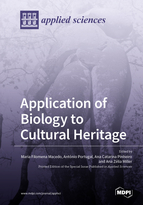Application of Biology to Cultural Heritage
A special issue of Applied Sciences (ISSN 2076-3417). This special issue belongs to the section "Applied Biosciences and Bioengineering".
Deadline for manuscript submissions: closed (20 July 2021) | Viewed by 32519
Special Issue Editors
Interests: preventive conservation; cultural heritage; biocides; biodiversity; biodeterioration
Special Issues, Collections and Topics in MDPI journals
2. Fitolab, Laboratory for Phytopathology, Instituto Pedro Nunes, 3030-199 Coimbra, Portugal
Interests: mycology; biodeterioration; cultural heritage; genetics; phytopathology
Special Issues, Collections and Topics in MDPI journals
Interests: ecology; microbiology; environmental microbiology; PCR; cloning; microbial ecology; minerals; geochemistry; bacteria; fungi
Interests: conservation and restoration; parchment studies; biocodicology; DNA; metagenomics; proteomics
Special Issues, Collections and Topics in MDPI journals
Special Issue Information
Dear Colleagues,
This Special Issue on “Application of Biology to Cultural Heritage” aims to cover all the latest outstanding developments of biological and biochemical methods that have been developed and applied to cultural heritage.
Cultural heritage biodiversity has received much research attention in recent years. This Special Issue intends to provide a comprehensive examination of the science of biology and its practical application for the preservation of cultural heritage. In this issue, research papers or reviews on all aspects of biological causes, modes of action, biocidal treatment, and protection and prevention of cultural heritage are welcome, as well as biodeterioration of cultural heritage studies. Analysis and testing of macro- and microorganisms affecting the preservation of cultural heritage are also welcome.
The knowledge that has arisen from studies of biology applied to the cultural heritage area may be translated into new conservation and restoration treatments.
This issue addresses researchers from both academia and industry, working in microbiology and biotechnology.
This Special Issue does not include theoretical bioinformatics, medical microbiology or phytopathological microbiology.
Prof. Dr. Maria Filomena Macedo
Prof. Dr. António Portugal
Dr. Ana Miller
Dr. Ana Catarina Pinheiro
Guest Editors
Manuscript Submission Information
Manuscripts should be submitted online at www.mdpi.com by registering and logging in to this website. Once you are registered, click here to go to the submission form. Manuscripts can be submitted until the deadline. All submissions that pass pre-check are peer-reviewed. Accepted papers will be published continuously in the journal (as soon as accepted) and will be listed together on the special issue website. Research articles, review articles as well as short communications are invited. For planned papers, a title and short abstract (about 100 words) can be sent to the Editorial Office for announcement on this website.
Submitted manuscripts should not have been published previously, nor be under consideration for publication elsewhere (except conference proceedings papers). All manuscripts are thoroughly refereed through a single-blind peer-review process. A guide for authors and other relevant information for submission of manuscripts is available on the Instructions for Authors page. Applied Sciences is an international peer-reviewed open access semimonthly journal published by MDPI.
Please visit the Instructions for Authors page before submitting a manuscript. The Article Processing Charge (APC) for publication in this open access journal is 2400 CHF (Swiss Francs). Submitted papers should be well formatted and use good English. Authors may use MDPI's English editing service prior to publication or during author revisions.
Keywords
- cultural heritage
- biology
- biochemical
- conservation and restoration
- preservation
- treatment
- biocides
- biodiversity
- biodeterioration









